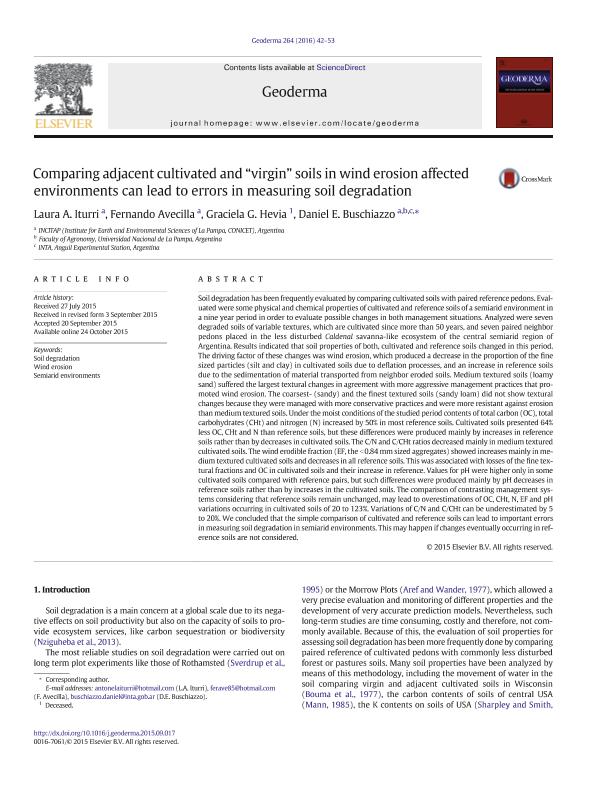Artículo
Comparing adjacent cultivated- and "virgin" soils in wind erosion affected environments can lead to errors in measuring soil degradation
Fecha de publicación:
02/2016
Editorial:
Elsevier Science
Revista:
Geoderma
ISSN:
0016-7061
Idioma:
Inglés
Tipo de recurso:
Artículo publicado
Clasificación temática:
Resumen
Soil degradation has been frequently evaluated by comparing cultivated soils with paired reference pedons. Evaluated were some physical and chemical properties of cultivated and reference soils of a semiarid environment in a nine year period in order to evaluate possible changes in both management situations. Analyzed were seven degraded soils of variable textures, which are cultivated since more than 50 years, and seven paired neighbor pedons placed in the less disturbed Caldenal savanna-like ecosystem of the central semiarid region of Argentina. Results indicated that soil properties of both, cultivated and reference soils changed in this period. The driving factor of these changes was wind erosion, which produced a decrease in the proportion of the fine sized particles (silt and clay) in cultivated soils due to deflation processes, and an increase in reference soils due to the sedimentation of material transported from neighbor eroded soils. Medium textured soils (loamy sand) suffered the largest textural changes in agreement with more aggressive management practices that promoted wind erosion. The coarsest- (sandy) and the finest textured soils (sandy loam) did not show textural changes because they were managed with more conservative practices and were more resistant against erosion than medium textured soils. Under the moist conditions of the studied period contents of total carbon (OC), total carbohydrates (CHt) and nitrogen (N) increased by 50% in most reference soils. Cultivated soils presented 64% less OC, CHt and N than reference soils, but these differences were produced mainly by increases in reference soils rather than by decreases in cultivated soils. The C/N and C/CHt ratios decreased mainly in medium textured cultivated soils. The wind erodible fraction (EF, the < 0.84 mm sized aggregates) showed increases mainly in medium textured cultivated soils and decreases in all reference soils. This was associated with losses of the fine textural fractions and OC in cultivated soils and their increase in reference. Values for pH were higher only in some cultivated soils compared with reference pairs, but such differences were produced mainly by pH decreases in reference soils rather than by increases in the cultivated soils. The comparison of contrasting management systems considering that reference soils remain unchanged, may lead to overestimations of OC, CHt, N, EF and pH variations occurring in cultivated soils of 20 to 123%. Variations of C/N and C/CHt can be underestimated by 5 to 20%. We concluded that the simple comparison of cultivated and reference soils can lead to important errors in measuring soil degradation in semiarid environments. This may happen if changes eventually occurring in reference soils are not considered.
Palabras clave:
Soil Degradation
,
Wind Erosion
,
Semiarid Environments
Archivos asociados
Licencia
Identificadores
Colecciones
Articulos(INCITAP)
Articulos de INST.D/CS D/L/TIERRA Y AMBIENTALES D/L/PAMPA
Articulos de INST.D/CS D/L/TIERRA Y AMBIENTALES D/L/PAMPA
Citación
Iturri, Laura Antonela; Avecilla, Fernando; Hevia, Graciela Gloria; Buschiazzo, Daniel Eduardo; Comparing adjacent cultivated- and "virgin" soils in wind erosion affected environments can lead to errors in measuring soil degradation; Elsevier Science; Geoderma; 264; Part A; 2-2016; 42-53
Compartir
Altmétricas




